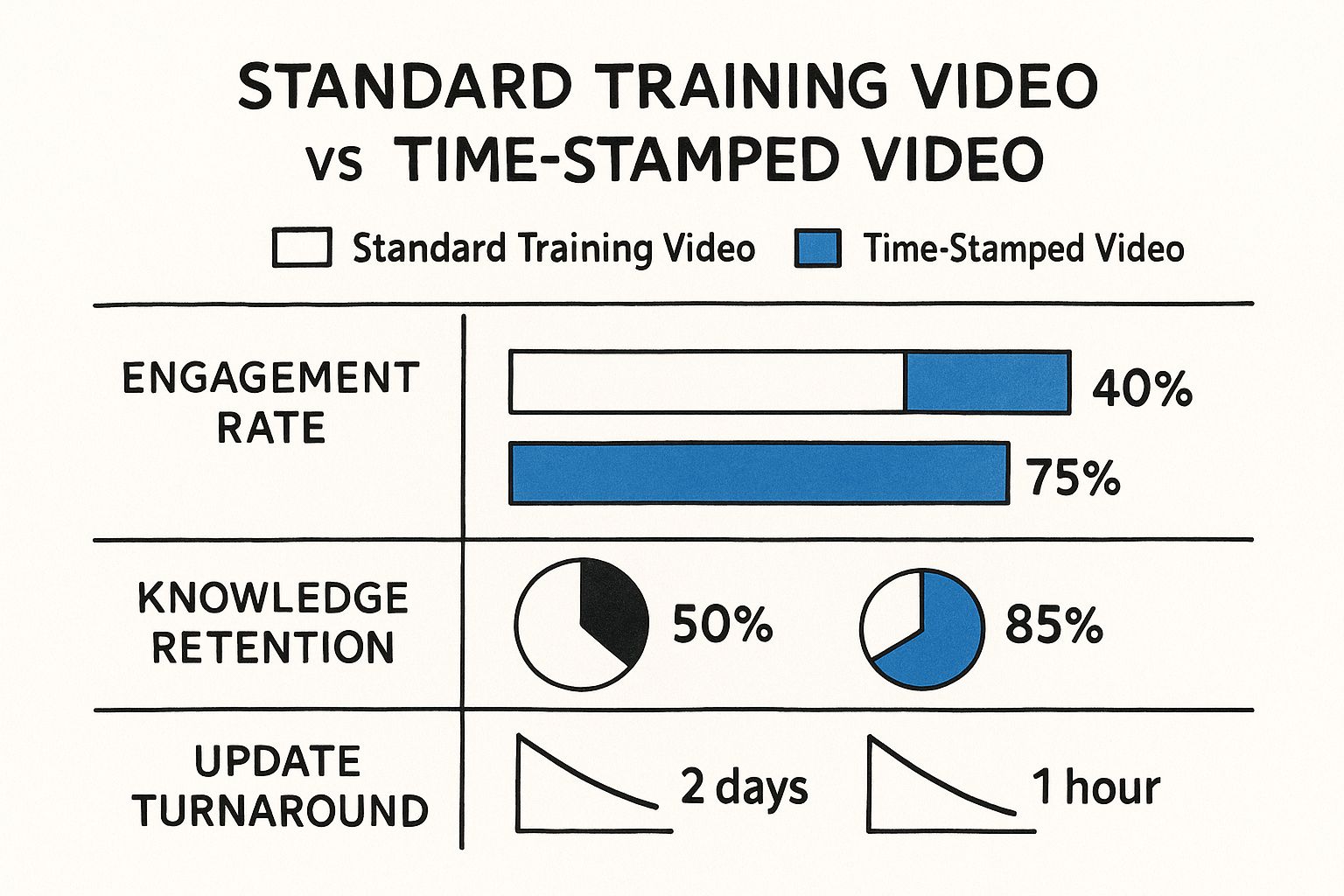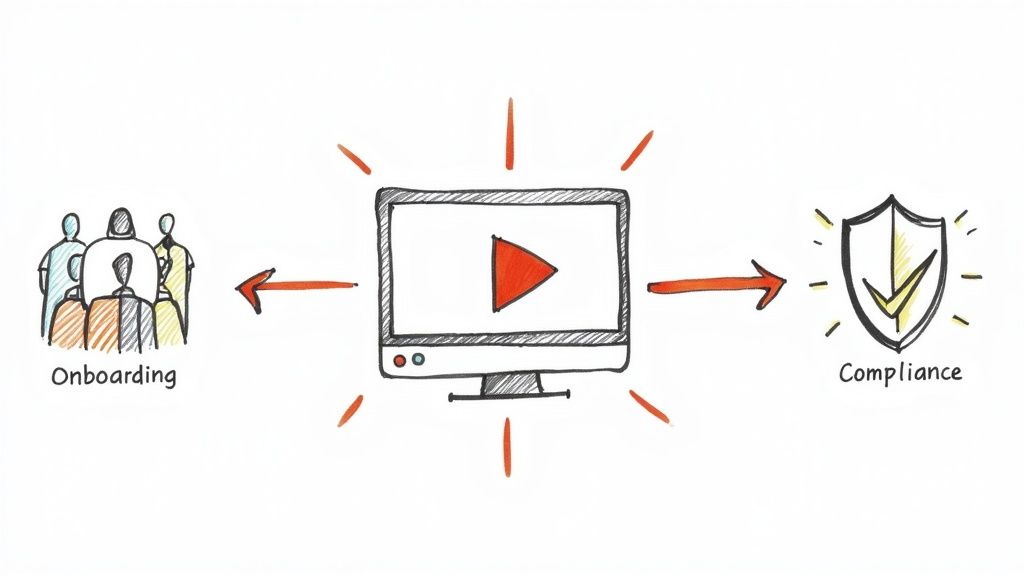
Elevate Corporate Learning with Time Stamped Video
Let's be honest, most corporate training videos are a one-way street. Employees are forced to sit through long lectures, hoping to catch the one or two key pieces of information they actually need for their job.
What if there was a better way? Imagine a training tool where your team could instantly jump to the exact procedure they're looking for, quickly review a critical safety protocol, or skip the modules they've already mastered. That's the power of a time stamped video for corporate training.
The Future of Training Is Navigable, Interactive Video
By adding simple, clickable chapters, you can transform a standard, linear training video into an efficient, on-demand learning resource. This isn't just a minor tweak; it's a fundamental shift in how people interact with educational content. It moves them from being passive viewers to active participants in their own professional development.
This move toward searchable, user-driven content is right in line with how we consume information everywhere else. Video is king, and its dominance is only growing. Projections show that by 2025, video will make up a staggering 82% of all global internet traffic. People prefer video, and they expect to be in control of how they watch it—especially in a learning environment.
Why Navigable Video Matters for Corporate Training
In a fast-paced work environment, nobody has time to waste. Your team can't afford to scrub through an hour-long module just to find a two-minute answer. Navigable video cuts through the noise by delivering:
- Instant Access: Employees can find specific information in seconds, turning training material into a genuine performance support tool they can use on the job.
- Personalized Learning Paths: Learners can focus on the topics where they need the most help and breeze past content they already know. It respects their existing knowledge and expertise.
- Improved Engagement: When you give viewers control, they stay focused. The content feels more relevant to their immediate needs, which keeps them locked in and boosts knowledge retention.
Let’s look at how this plays out in a real-world training scenario.
Time Stamped Video vs Traditional Training Video
The table below breaks down the key differences between a standard training video and one that's been enhanced with timestamps or chapters. It's a night-and-day difference in terms of the learner's experience and, ultimately, the effectiveness of the training itself.
As you can see, the simple act of adding navigation fundamentally changes the dynamic. It shifts the video from a "push" model (where you push information at the learner) to a "pull" model (where the learner pulls the exact information they need, right when they need it).
This infographic really drives the point home, comparing the impact of standard training videos against their time-stamped counterparts.

The data is clear: navigable video doesn't just improve the experience—it nearly doubles engagement and gives knowledge retention a serious boost.
By making content searchable and skippable, you respect the learner's time and empower them to take control of their training. This simple adjustment can lead to major gains in efficiency and comprehension.
New tools are constantly making this process easier, too. The latest advancements in tech, including the top speech-to-text apps, are paving the way for even more dynamic and accessible training experiences. With platforms like Mindstamp, you can easily break your videos into searchable, navigable sections and start building a smarter, more effective training library today.
What Is a Time Stamped Video in Corporate Training
Let’s be honest: nobody loves scrubbing through a long training video, trying to pinpoint that one specific piece of information they need. That’s where a time stamped video completely changes the game.
At its heart, a time stamped video is simply a training video with a built-in, clickable navigation menu. Think of it like an interactive table of contents that lives right inside the video player itself. Instead of guesswork, your employees get a clear roadmap of the content.
So, instead of dragging the playhead back and forth, learners can just click a chapter title like ‘Jump to Safety Protocols (5:32)’ or ‘Review Q3 Onboarding Procedures (12:15)’ from an on-screen menu. It’s a simple concept, but it fundamentally redefines how people interact with training material.
Shifting from Passive Viewing to Active Exploration
This small change makes a massive difference, especially in a corporate setting. It turns the entire experience from passive, linear viewing into active, self-directed exploration. Employees are no longer trapped, forced to sit through sections they already understand or that aren’t relevant to their immediate problem.
This single feature transforms your training assets from a one-time watch into a long-term performance support tool. Your video becomes a living resource, a go-to library that employees can revisit whenever they need a quick refresher. This kind of "just-in-time" learning is exactly what you need to reinforce complex topics and make sure knowledge is actually being applied on the job.
By letting learners find what they need, when they need it, time stamped video bridges the gap between a formal training session and real-world application. It makes learning a continuous, on-demand process, not a one-off event.
The Anatomy of a Navigable Training Video
So, what does this look like in practice? A well-designed, time stamped training video isn't just a video with a few links thrown in. It’s a thoughtfully structured learning tool with a few key components that work together to create an effortless experience.
Here’s what you can expect to find:
- A Chapter Menu: This is an organized, clickable list of all the main topics covered. It usually sits right alongside the video player for easy access at any time.
- Timestamped Markers: Think of these as little signposts directly on the video’s timeline. Each one corresponds to a specific topic or sub-topic, allowing for super-granular navigation.
- Clear Topic Titles: Each chapter needs a descriptive, intuitive title. No more guessing—the learner knows exactly what they're clicking on.
Tools like Mindstamp are built for this. They allow you to add all these elements directly into your videos, creating a polished and intuitive interface. You’re not just sending out a video file; you’re delivering a powerful, interactive training module that respects your team's time and intelligence. The end result? Better engagement, better retention, and training that actually sticks.
Unlock Key Benefits for Learning and Development
When you weave timestamps into your training videos, you’re not just adding a feature—you’re fundamentally changing how your team learns. The most obvious win is navigability. Suddenly, employees can find the exact piece of information they need, right when they need it.
This transforms training from a scheduled event into a "just-in-time" resource. Instead of forcing someone to rewatch an entire 30-minute module just to recall one specific step, they can jump right to the relevant part. This small change massively boosts knowledge retention and makes your content far more accessible for people who learn at different speeds.

This shift toward user-controlled video isn’t happening in a vacuum. By 2025, a staggering 89% of businesses are using video for outreach. More importantly, 95% of video marketers now consider it a core part of their strategy. The takeaway is clear: video isn't just an option anymore; it's central to how we communicate. If you're curious, you can dig into more 2025 video marketing statistics to see the whole picture.
Foster a Learner-Centric Training Ecosystem
For Learning and Development (L&D) teams, a time stamped video is also a dream to manage. Imagine a compliance policy changes. Instead of a painful process of re-editing and re-uploading a massive video file, you can just direct learners to a newly added section or update a single chapter link. Simple.
This agility helps you build a more responsive, learner-centric training program. You move away from static, one-and-done training events and toward a living library of resources that supports continuous improvement.
When employees can navigate content freely, they develop a sense of ownership over their learning. This autonomy fosters mastery and encourages them to use training materials as ongoing performance support tools, not just one-time assignments.
This approach delivers a much clearer return on your content investment. A single, well-structured training video can serve multiple needs:
- Initial Onboarding: New hires can watch from start to finish for a complete overview.
- On-the-Job Reference: An experienced employee can jump directly to a specific procedural step when they need a quick refresher.
- Skill Reinforcement: A team member can quickly revisit a section to brush up on a concept before a big project.
Improve Engagement and Completion Rates
Let's be honest, long videos can be intimidating. By breaking down your content into digestible, timestamped segments, you’re acknowledging modern attention spans and learning styles. Each timestamp acts like a mini-milestone, giving learners a sense of progress that keeps them moving forward.
This structure naturally boosts engagement. But platforms like Mindstamp let you take it to another level entirely. You can add interactive elements like questions, polls, or links to additional resources at specific timestamps.
By turning passive viewing into an active, hands-on experience, you don't just improve completion rates—you ensure your training messages are actually being understood and retained.
Where Timestamps Shine in Corporate Training
The real magic of a timestamped video happens when you see it in action across the business. From a new hire’s first day to a high-level leadership seminar, this simple tool solves some of the biggest training headaches by making content easy to find and even easier to use.

Take employee onboarding. The impact is immediate. Instead of forcing someone to sit through a linear, hours-long welcome video, you can empower them to navigate a full introduction at their own pace.
They can bounce between modules on company culture, HR policies, and department deep-dives, zeroing in on what matters most to their role first. This approach is a game-changer for everything from general orientation to specialized training like video marketing onboarding, giving new team members control over their learning from day one.
Making Technical and Compliance Training Stick
When it comes to technical or software training, timestamps transform a video into an essential on-the-job tool. Imagine an employee getting the hang of a new CRM. When they get stuck trying to do something specific, they don't have to scrub through an entire tutorial.
Instead, they just click a chapter marker labeled "How to Export a Report" and get the exact steps they need, right when they need them. The video evolves from a one-time lesson into a reference guide they'll use again and again.
Compliance training—often dense and mandatory—also gets a major upgrade. Timestamps make the material far more manageable. You can bookmark critical sections covering legal standards or safety protocols, making it easy for employees to jump back and review. This not only boosts comprehension but also creates an easily referenced record when a specific question pops up.
A time stamped video serves multiple roles simultaneously: it's an initial teaching tool, an on-demand reference guide, and a reinforcement mechanism. This versatility maximizes the ROI on your training content creation.
Supporting Leadership Development
Even soft-skills training like leadership development benefits massively from timestamps. Those lengthy seminars and recorded workshops suddenly feel much more approachable when broken down into logical, clickable sections.
A manager prepping for a tough conversation can jump straight to a module on 'Delivering Constructive Feedback' or 'Conflict Resolution Strategies' in their moment of need. This targeted approach respects the tight schedules of senior staff and encourages them to actually use training resources for real-world problem-solving. By making your corporate training videos more effective, you empower leaders to continuously sharpen their skills.
And platforms like Mindstamp take this a step further. You can add interactive questions or links within these chapters, turning what was a passive viewing session into an active learning experience that drives real behavioral change.
How to Create Your First Time Stamped Video
If you're looking to turn a standard training video into a more powerful, navigable learning tool, timestamps are the way to go. But getting started can feel like a big step. In fact, among professionals who haven't jumped into video yet, 37% say they're just not sure where to begin, while over 25% point to time as a major roadblock. You can dig into more of these insights on video adoption challenges here.
The good news? Creating a time stamped video doesn’t have to be a massive, complicated project. You can start with a simple manual approach or jump right in with a specialized platform for a much more professional—and data-rich—result.
The Manual Approach
The most basic way to add timestamps is to just list them out in your video’s description on a platform like YouTube. It's as simple as it sounds: you watch your video, jot down the start time for each key topic, and type it out in a MM:SS Topic format.
A description might look something like this:
- 00:00 Introduction to Safety Protocols
- 01:45 Proper Use of Equipment
- 04:10 Emergency Procedures
This method is totally free and incredibly straightforward. The downside? It forces the viewer to look away from the video to navigate, creating a clunky, disjointed experience. It’s a decent first step, but it just doesn’t have the seamless feel you need for truly effective corporate training.
Using an Interactive Video Platform
For a genuinely better training experience, a dedicated interactive video platform like Mindstamp is your best bet. Forget a simple text list in the description—Mindstamp lets you build a clickable table of contents directly inside the video player itself.
The interface makes it easy to add chapters and other interactive elements, which results in a polished, professional-looking final product.
This visual approach gives your learners a slick UI where they can see the entire video structure and jump to any chapter without ever leaving the player.
But the real magic of a platform like Mindstamp isn't just about easier navigation. It's about the data. You suddenly unlock powerful analytics that show you which sections people watch most, where they tend to drop off, and how they respond to in-video questions.
This kind of insight is pure gold for refining your training. You can instantly spot confusing topics, identify areas that need more detail, and constantly improve your programs based on how your team actually interacts with the content. When you move beyond manual timestamps, you're not just making a video—you're creating a smarter, more measurable training ecosystem.
Go Beyond Navigation with Interactive Timestamps
Standard timestamps are great for helping people find exactly what they're looking for, but what if they could do more? Interactive timestamps are designed to help your team truly engage with that information, not just find it.
This is where the simple idea of a time stamped video transforms into a seriously powerful tool for corporate training. Platforms like Mindstamp take chapter markers and turn them from simple navigation points into dynamic opportunities for interaction.
Instead of just jumping to a new section, a click can trigger a pop-up question to check for understanding, reveal a downloadable PDF with more details, or open a link to a relevant resource. Your video is no longer a passive file but an active, two-way learning tool. It’s no longer just about watching; it’s about doing.
Turning Chapters into Learning Moments
Picture your latest sales process training video. After a timestamped segment on objection handling, you could pop in a short, multiple-choice quiz to lock in the key takeaways. This immediate feedback helps the learning stick and quickly flags any knowledge gaps.
This approach is a game-changer for complex topics. Just think about the possibilities:
- Technical Training: A chapter on a tricky procedure could link directly to a detailed schematic stored in your company's knowledge base.
- Compliance Updates: A section on new regulations can include a clickable link to the full policy document for anyone who needs to dig deeper.
- Software Tutorials: Timestamps can launch interactive "show me" simulations where employees can practice a task right then and there.
This kind of engagement drives much deeper learning and confirms comprehension in a way that just watching a video never could.
Interactive timestamps shift the focus from content delivery to learning verification. By embedding activities directly at the point of learning, you create a more effective and measurable training experience that ensures your team doesn't just watch—they understand.
Building a Richer Training Ecosystem
By layering interactivity onto your time stamped video, you're not just segmenting a long recording; you're building a whole network of connected resources.
This also makes your content far more discoverable. For instance, you can search your videos using interactive transcripts on Mindstamp, which makes finding specific moments even easier for your team.
Ultimately, this moves your corporate training from a simple "check-the-box" activity to a dynamic system that supports employees when and how they need it most. It’s a smarter way to train, ensuring that every minute spent watching a video delivers real, measurable value.
Got Questions? We’ve Got Answers.
As Learning and Development teams start digging into how to make their training more effective, timestamped video naturally brings up a few questions. Let's tackle some of the most common ones.
How Do You Actually Know if a Time Stamped Video is Working?
The real magic of using a platform like Mindstamp isn't just adding chapters—it's the data you get back. A standard video just gives you a view count, which doesn't tell you much. Interactive platforms, on the other hand, deliver deep analytics that show you exactly what's resonating and what's not.
Here are the key metrics you'll want to watch:
- Chapter Views: See which sections people are watching the most. If you notice a specific chapter is getting replayed over and over, that’s a huge clue. It might be a particularly complex topic that needs a bit more explanation, or it could be something absolutely critical for their day-to-day work.
- Viewer Drop-Off Points: Pinpoint the exact moment learners start to lose interest. This is invaluable for refining your content and improving the pacing of future training modules.
- Question and Quiz Responses: By adding quick questions at key timestamps, you can directly measure if people are absorbing the material. This lets you spot exactly where employees are struggling.
This kind of granular data turns your video from a one-way broadcast into a powerful feedback loop. You can finally move beyond simple completion rates and start measuring real understanding, making it much easier to prove the ROI of your training.
How Do I Pick the Right Platform for This?
While you can add basic timestamps on a platform like YouTube, corporate training requires something far more robust and secure. You really want to look for a platform that was built from the ground up with training and engagement in mind.
Consider these factors when you're looking around:
- Interactive Features: Does it go beyond simple chapter markers? Look for the ability to add questions, buttons, hotspots, and links directly into the video itself.
- Detailed Analytics: The platform absolutely has to provide viewer-specific data. You need to be able to track individual progress and measure comprehension to see what's working.
- Ease of Use: A great platform should have an intuitive interface. Your L&D team should be able to jump in and add timestamps and interactive elements without needing a degree in video engineering.
Can I Add Timestamps to the Videos I Already Have?
Absolutely. You don’t need to reshoot your entire training library to get the benefits. In fact, one of the biggest wins is being able to breathe new life into the videos you've already created.
Just upload your existing MP4s or other video files to a platform like Mindstamp, and you can start adding chapters, questions, and other interactive features in minutes. It's a quick way to add a ton of value to your current assets and make them far more engaging and measurable.
Ready to see what your corporate training videos can really do? With Mindstamp, you can easily turn your passive videos into active, data-rich learning experiences. Start creating your first interactive timestamped video today by visiting https://mindstamp.com.
Get Started Now
Mindstamp is easy to use, incredibly capable, and supported by an amazing team. Join us!



Try Mindstamp Free










